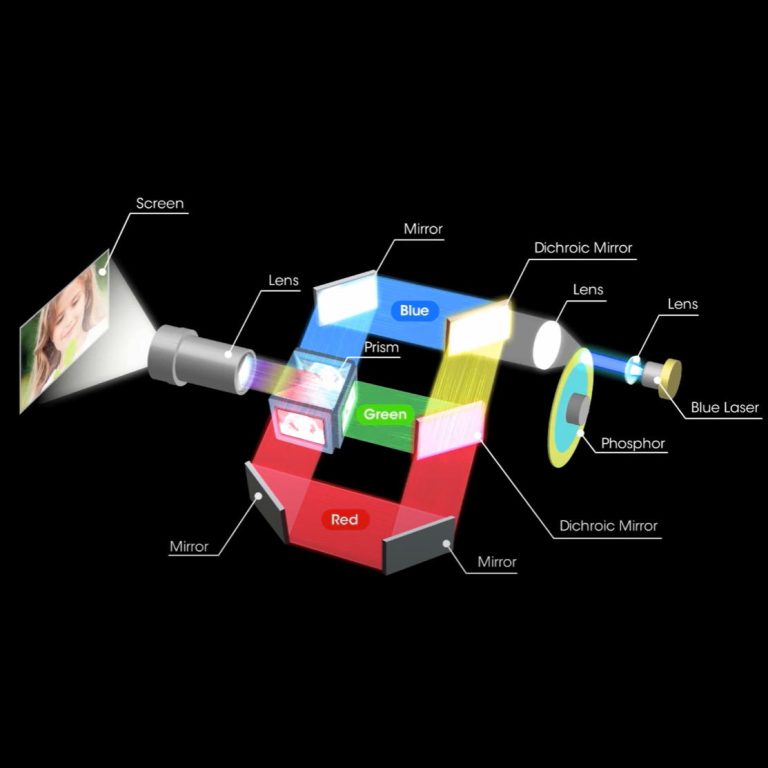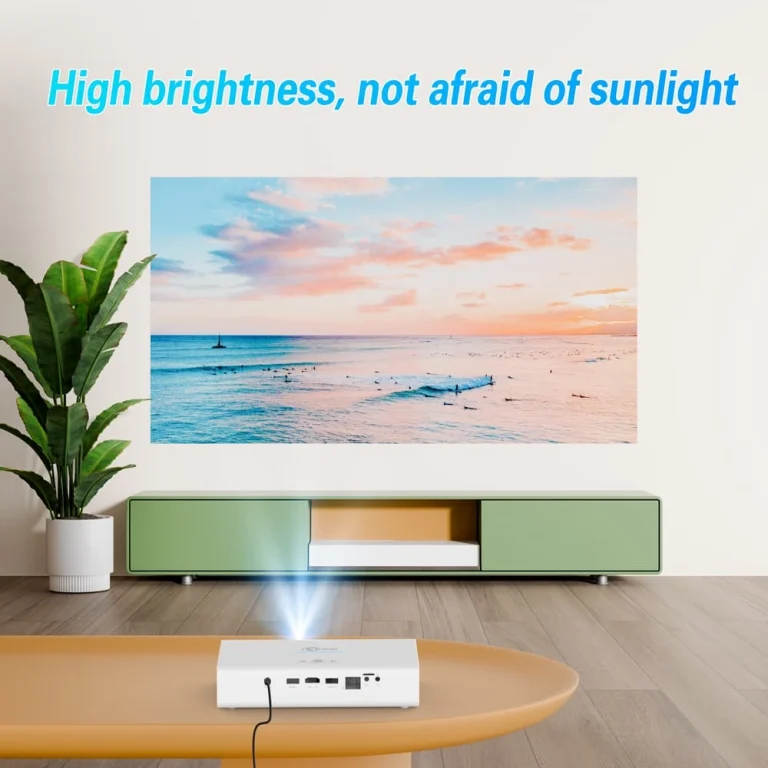Introduction: Why Choose a DLP Projector?
Projectors are everywhere now—from home theaters to business meetings to classrooms. Among the three main types—LCD, DLP, and laser—DLP is the go-to for users who want sharp images, compact design, and long-term durability. In this guide, you’ll learn how DLP projectors work, what makes them stand out, and how to choose the right one.
1. Comparing the Top 3 Projection Technologies
LCD Projectors
-
How it works: Uses liquid crystal panels to control light.
-
Pros: Softer color tones.
-
Cons: Prone to “screen door effect” (visible pixel gaps) and usually bulkier.
Laser Projectors
-
How it works: Uses laser light sources.
-
Pros: Super bright, long-lasting.
-
Cons: High cost. RGB laser models may show speckle artifacts.
DLP Projectors
-
How it works: Uses a chip with millions of tiny mirrors (DMD chip) to reflect light precisely.
-
Pros: Crisp images, accurate colors, compact design.
2. How DLP Technology Works
At the heart of a DLP projector is a DMD chip developed by Texas Instruments. Each chip contains millions of micromirrors that rapidly tilt to direct light either toward or away from the lens. When combined with a color wheel or a triple-chip setup, this creates sharp, vibrant digital images with high color accuracy.
3. Top 5 Benefits of DLP Projectors
1. Sharp and High-Contrast Images
DLP projectors produce very fine images with pixel gaps under 1 micron. Contrast ratios often exceed 20,000:1, which means deeper blacks and brighter whites—perfect for movies or detailed presentations.
2. Compact and Travel-Friendly
Because DLP projectors have a more streamlined design, they’re smaller and lighter. For example, the TOUMEI S7 comes with a carrying case and built-in battery—great for mobile professionals or backyard movie nights.
3. Long Lifespan and Dust Resistance
DLP projectors have a sealed optical engine that keeps dust out, reducing image degradation over time. Light sources last up to 30,000 hours, and the DMD chip itself can last over 100,000 hours.
4. Smooth, Quiet Operation
Thanks to faster refresh rates and fewer moving parts, DLP projectors are great for fast-paced video and gaming. They also run quietly—usually under 30 dB.
5. Versatility for Any Use Case
DLP projectors are used in everything from 4K home theaters to professional exhibitions. Triple-chip models offer premium color coverage, while single-chip units offer great value for classrooms and meetings.
4. DLP vs. LCD vs. Laser: Which Is Right for You?
DLP vs. LCD
-
Image Quality: DLP is sharper with better contrast.
-
Size: DLP is more portable.
-
Maintenance: DLP is more dust-resistant.
DLP vs. Laser
-
Brightness & Lifespan: Laser is top-tier, but pricey.
-
Visual Artifacts: RGB laser can cause speckles; DLP avoids that.
-
Overall Value: DLP balances quality and affordability better.
5. Buying Tips & Use Case Recommendations
For Home Entertainment
Look for at least 1080p or 4K resolution and 600 ANSI lumens for daytime viewing.
Top Pick: TOUMEI S7—portable, sharp image, and battery-powered.
For Business & Classrooms
Go for 3000+ lumens to deal with bright rooms. Make sure it’s dust-proof and has a long-lasting lamp.
For Professional AV & Large Venues
Choose a triple-chip DLP projector for high brightness and accurate colors—ideal for exhibitions, theaters, or simulation setups.
6. Feature Comparison Table
| Feature | DLP | LCD | Laser |
|---|---|---|---|
| Image Quality | Sharp, high contrast | Softer, can pixelate | Extremely bright, accurate |
| Portability | Compact | Bulky | Moderate |
| Maintenance | Low, dust-resistant | High, dust-sensitive | Low, but high cost |
| Cost | Affordable to mid-range | Affordable | Expensive |
| Noise Level | Low (<30 dB) | Moderate | Low |
| Lifespan | 30,000+ hours | 10,000–20,000 hours | 20,000–30,000+ hours |
Frequently Asked Questions (FAQ)
Q1: What is the typical lifespan of a DLP projector?
A: The light source lasts up to 30,000 hours, and the DMD chip can last over 100,000 hours.
Q2: Are DLP projectors good for gaming?
A: Yes. They offer fast refresh rates and low latency—ideal for gaming.
Q3: Do DLP projectors work in bright rooms?
A: Yes, especially if the brightness is 3000 lumens or more.
Q4: What’s the difference between single-chip and triple-chip DLP?
A: Triple-chip models provide better color and brightness for professional setups. Single-chip models are more affordable and portable.
Conclusion: DLP Is the Future of Projection
DLP projectors offer sharp visuals, durable components, and flexible usage—whether at home, in the office, or in professional settings. If you want high performance without the bulk or maintenance hassle, DLP is the smart way forward.





